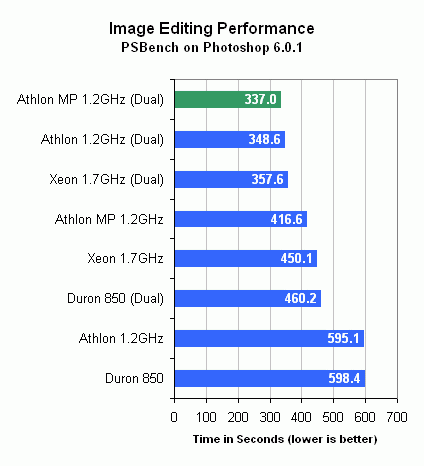AMD 760MP & Athlon MP - Dual Processor Heaven
by Anand Lal Shimpi on June 5, 2001 12:00 PM EST- Posted in
- CPUs
Image Editing Performance
Today we live in an increasingly 3D world, at least when it comes to the hardware industry. There is a constant drive to bring as many technologies as possible to the third dimension; first it was modeling, then games, and now even scanners but we can't forget that a lot of content creation and manipulation is still of two dimensional pictures.
Case in point would be Adobe Photoshop; undeniably the most well known 2D image editing package available today. In 3D Studio MAX, rendering and animation take the bulk of the time but in Photoshop, applying filters is what eats up the CPU cycles. Photoshop isn't as multithreaded as 3D Studio MAX but certain filters in Photoshop are multithreaded. With the latest patches and updates to the software, Photoshop 6.0.1 can also boast improved performance with the Pentium 4 and thus the Xeon as well.
In order to benchmark Photoshop we used PSBench which takes us through a sequence of applying around 20 filters individually (and reverting back to the original image afterwards) to a 50MB image. The performance is measured as time in seconds and is broken down according to the following table:
|
|
Duron
850
|
Duron
850 (Dual)
|
Athlon
1.2GHz
|
Athlon
1.2GHz (Dual)
|
Athlon
MP 1.2GHz
|
Athlon
MP 1.2GHz (Dual)
|
Intel Xeon 1.7GHz (Dual)
|
Intel Xeon 1.7GHz
|
Intel Pentium III 933MHz (Dual)
|
|
|
Filter/Action
|
Time to Complete in Seconds (lower is better)
|
|||||||||
| Rotate 90 |
8.0
|
8.7
|
7.2
|
7.5
|
7.8
|
8.2
|
7.9
|
7.8
|
6.8
|
|
| Rotate 9 |
15.2
|
13.2
|
14.4
|
10.3
|
11.4
|
10.5
|
10.9
|
13.8
|
10.7
|
|
| Rotate .9 |
16.0
|
12.5
|
14.4
|
10.6
|
11.8
|
10.8
|
11.1
|
13.0
|
10.3
|
|
| Gaussian Blur 1 pixel |
7.4
|
6.2
|
6.9
|
6.0
|
6.4
|
6.0
|
6.3
|
6.6
|
5.1
|
|
| Gaussian Blur 3.7 pixels |
15.9
|
12.4
|
16.6
|
10.5
|
12.1
|
10.7
|
10.5
|
11.8
|
11.4
|
|
| Gaussian Blur 85 pixels |
18.0
|
13.7
|
18.5
|
12.1
|
13.4
|
11.6
|
10.9
|
12.6
|
12.4
|
|
| 50%, 1 pixel, 0 level Unsharp Mask |
6.5
|
5.4
|
5.7
|
4.3
|
4.3
|
4.2
|
4.4
|
5.3
|
4.4
|
|
| 50%, 3.7 pixel, 0 level Unsharp Mask |
16.4
|
12.7
|
17.1
|
11.7
|
13.0
|
11.1
|
10.7
|
12.2
|
11.7
|
|
| 50%, 10 pixel, 5 level Unsharp Mask |
16.5
|
12.9
|
17.3
|
11.8
|
13.3
|
11.0
|
10.9
|
12.7
|
11.9
|
|
| Despeckle |
10.6
|
7.3
|
10.0
|
5.1
|
7.1
|
5.1
|
6.7
|
9.5
|
7.1
|
|
| RGB-CMYK |
29.5
|
29.5
|
28.2
|
21.0
|
20.5
|
20.2
|
26.6
|
26.5
|
26.7
|
|
| Reduce Size 60% |
5.2
|
3.7
|
5.3
|
2.9
|
3.7
|
2.9
|
2.8
|
3.3
|
3.2
|
|
| Lens Flare |
19.7
|
13.6
|
19.7
|
12.2
|
15.8
|
12.6
|
12.6
|
16.0
|
14.4
|
|
| Color Halftone |
28.7
|
28.4
|
28.8
|
20.0
|
18.8
|
19.2
|
30.1
|
30.8
|
3.3
|
|
| NTSC Colors |
11.1
|
11.4
|
9.8
|
7.6
|
7.1
|
7.3
|
8.6
|
8.4
|
9.4
|
|
| Accented Edges Brush Strokes |
34.3
|
34.5
|
34.0
|
24.1
|
23.3
|
23.6
|
25.1
|
25.7
|
28.3
|
|
| Pointillize |
57.4
|
34.7
|
57.7
|
26.7
|
41.6
|
26.7
|
26.2
|
42.1
|
29.7
|
|
| Water Color |
69.2
|
70.0
|
69.9
|
48.7
|
45.2
|
45.5
|
54.1
|
54.4
|
58.5
|
|
| Polar Coordinates |
33.0
|
23.8
|
35.6
|
16.0
|
22.7
|
15.5
|
17.3
|
28.1
|
Failed
|
|
| Radial Blur |
154.7
|
88.1
|
153.8
|
66.8
|
109.4
|
66.3
|
57.5
|
101.8
|
70.2
|
|
| Lighting Effects |
25.1
|
17.4
|
24.0
|
12.7
|
8.0
|
8.1
|
6.4
|
7.7
|
8.4
|
|
The total time taken to complete the filters is represented by the following graph:
The Xeon continues to remain competitive but the Athlon MP does nothing short of dethroning its Intel based counterpart in yet another test. Even with Pentium 4/Xeon optimizations, Photoshop is clearly faster on 760MP.
Before you let the tempting taste of dual Durons for less than $100 (for the CPUs at least) notice that the Dual Duron 850 system performed worse than a single Athlon MP 1.2GHz. Moving to two slower CPUs is almost never more beneficial than sticking with a single but noticeably faster CPU; remember that SMP isn't nearly as efficient as we'd like it to be.
The Duron's smaller cache size also plays a part in its performance placement.











0 Comments
View All Comments